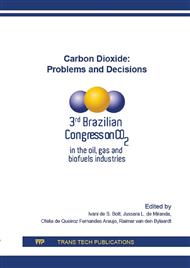[1]
COMISSION OF EUROPEAN COMMUNITIES. Communication from the commission to the council, the european parliament, the european economic and social committee and the committee of the region. Limiting Global Climate Change to 2 degrees Celsius The way ahead for 2020 and beyond. Bruxelas, (2007).
DOI: 10.1163/9789004322714_cclc_2020-0164-0816
Google Scholar
[2]
MDIC, SECEX, Information on: http: /aliceweb. desenvolvimento. gov. br. Accessed at 20/02/(2013).
Google Scholar
[3]
SOARES, L. H. B.; ALVES, B. J. R.; URQUIAGA, S.; BODDEY, R. M.S., Mitigação das Emissões de Gases Efeito Estufa pelo Uso de Etanol da Cana de Açuar Produzido no Brasil. Embrapa: Circular Técnica #27. Seropédica, RJ, Brasil. Abril, (2009).
DOI: 10.11606/d.86.2011.tde-10082011-152907
Google Scholar
[4]
ASSOCIAÇÃO BRASILEIRA DE NORMAS TÉCNICAS. NBR ISO 14040 Gestão Ambiental – Avaliação do ciclo de vida – Princípios e estrutura. Rio de Janeiro: ABNT– Associação Brasileira de Normas Técnicas, 2001. p.10.
DOI: 10.11606/d.18.2011.tde-25042011-103032
Google Scholar
[5]
IPCC. 2006 IPCC GUIDELINES FOR NATIONAL GREENHOUSE GAS INVENTORIES. Kanagawa: The Intergovernmental Panel on Climate Change (IPCC), 2006a. Technical Report.
DOI: 10.1007/springerreference_28950
Google Scholar
[6]
ASSOCIAÇÃO BRASILEIRA DE NORMAS TÉCNICAS. NBR ISO 14042 Gestão Ambiental – Avaliação do ciclo de vida. In: Abnt (Ed. ). Avaliação do ciclo de vida – Avaliação do impacto do ciclo de vida. Brasil. Rio de Janeiro: ABNT, 2004. Cap. 17.
DOI: 10.11606/t.3.2007.tde-08012008-151424
Google Scholar
[7]
MACEDO, I. C. Balanço de energia e emissões de GEE na produção do açúcar e álcool orgânicos na Usina São Francisco. Campinas, (2008).
DOI: 10.47749/t/unicamp.2016.982192
Google Scholar
[8]
BODDEY, R. M.; SOARES, L. H. D. B.; ALVES, B. J. R.; URQUIAGA, S. Bio- Ethanol Production in Brazil. In: Biofuels, solar and wind as renewable energy systems benefits and risks. New York Springer, 2008. p.32.
DOI: 10.1007/978-1-4020-8654-0_13
Google Scholar
[9]
MACEDO, I. D.; CARVALHO, E. P. A Energia da Cana-de-Açúcar – Doze estudos sobre a agroindústria da cana-de-açúcar no Brasil e a sua sustentabilidade. (Berlendis & Vertecchia) (p.65). São Paulo: UNICA - União da Agroindústria Canavieira do Estado de São Paulo, (2004).
DOI: 10.11606/t.11.1988.tde-20210104-160735
Google Scholar
[10]
MALÇA, J.; FREIRE, F. Renewability and life-cycle energy efficiency of bioethanol and bio-ethyl tertiary butyl ether (bioETBE): Assessing the implications of allocation. Energy, v. 31, n. 15, pp.3362-3380, (2006).
DOI: 10.1016/j.energy.2006.03.013
Google Scholar
[11]
DÍAZ, M. A. D.; CARVALHO, V. C. H. A, Field technical report –restricted disclosure. (2013).
Google Scholar
[12]
SAT. Personal interview with the board directors of the company See Algae Techonology,. (2011).
Google Scholar
[13]
CORTEZ, L. A. B., GOMEZ, E. O., A method for exergy analysis of sugarcane bagasse boilers, Brazilian Journal of Chemical Engineering, (1998).
Google Scholar
[14]
SILVA, P.R.F.; FREITAS, T.F.S. Biodiesel: o ônus e o bônus de produzir combustível. Programa de Pósgraduação em Fitotecnia, Faculdade de Agronomia, Departamento de Plantas de Lavoura, Universidade Federal do Rio Grande do Sul (UFRGS), Porto Alegre, RS, Brasil.
DOI: 10.21475/ajcs.18.12.03.pne619
Google Scholar
[15]
DÍAZ, M. A. D.; GOMES, M. S. P., Life cycle assessment of the Brazilian sugarcane ethanol aiming its environmental certification, MSc. Dissertation. Departamento de Engenharia Mecânica, Pontifícia Universidade Católica do Rio de Janeiro. Rio de Janeiro, 2011. 115p.
DOI: 10.29289/2594539420180000232
Google Scholar
[16]
ANP, Anual Report of the National Petroleum Agency, Brasilia, (2012).
Google Scholar


